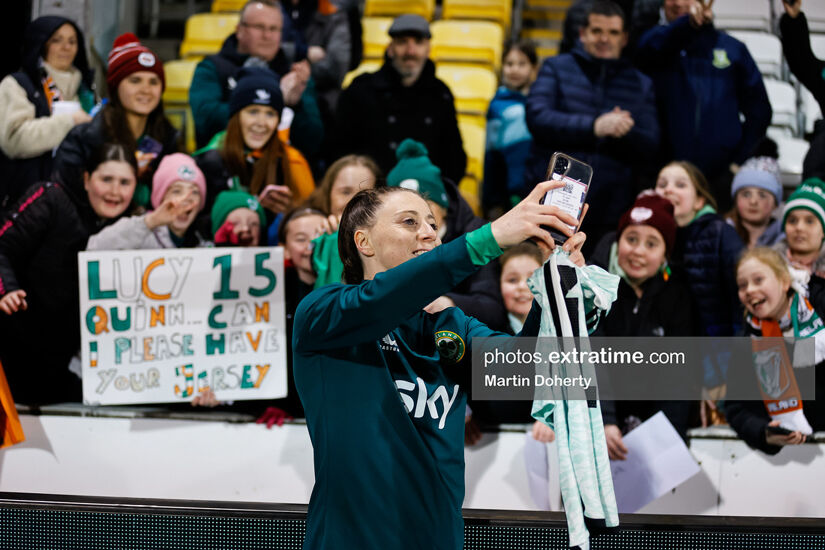Opinion: How the mainstream media is subtly undermining women’s football and, in turn, hurting its growth.

Lucy Quinn poses with Ireland fans after the Republic of Ireland -v- Wales at Tallagh Stadium on 27 February 2024. Credit: Martin Doherty (ETPhotos)
“Lack of media coverage to raise awareness of female sport is seen as the main reason for non-attendance at events, with 40 percent of people citing this as their reason. 65 percent of people think women’s sport does not get enough media coverage in Ireland, and 83 percent agree that men’s sport is covered more comprehensively.”
Research findings, commissioned by Lidl and Red C in 2023
As an avid fan of football and a part-time sports writer, there is nothing I enjoy more of a Sunday morning than sinking into an armchair in Costa with a Cappuccino nestled on my lap to thumb through the sports sections of the Sunday newspapers.
That was until I started to notice a trend, one that, once seen, was hard to ignore.
At the turn of the final page of a popular broadsheet, it dawned on me that I had not seen a mention of a single female soccer player (a female athlete, for that matter), nor a sports article penned by a female journalist.
Purchasing a heated scone with a frosting of sugar to take the edge off the shock, I thumbed through the pages of a second mainstream newspaper (another featuring a male sporting personality on the front cover).
At a fifth ‘schliff’of the newspaper (which I was pure rifling through in fairness), an elderly man astutely observed, “You're in your own world there, luv," nodding at the now creased broadsheet with a gummy grin.
Smiling back distractedly, I couldn’t help but wonder if he was right.
Perusing the newspapers on any given weekend (or morning for that matter), a fan of women’s football or sport could be forgiven for assuming that they had crash-landed into a parallel universe.
Let me set the scene.
You’ve watched Arsenal hammer Chelsea in the Men’s Premier League in blistering fashion on Sky Sports on Friday evening.
The following morning, nursing a hangover, you pick up a copy of the newspaper and a coffee at the local garage.
Amongst the column inches, there’s no reference to Artetas squad's thrilling win.
In fact, there’s no reference to any Premier League action.
A real head scratcher, right?
This is how I feel every time I watch a thrilling Women’s League of Ireland game - or lose my Saturday to an entertaining Sky Sports Main Event clash between Arsenal and Chelsea, only to find not a jot of ink the following morning on the contest.
Sure, I may (when the editor is feeling generous) find a brief match report, relegated to the online version of a publication, often written by a man (read the piece in full before launching an attack worthy of a defcon level 5 rating), or a monotonous account authored by the associated press, dry enough to have you reaching for a midweek Guinness, plugged to fill copy.
What’s MIA, however, are the colourful epochs, odes, analysis, and pontifications on women’s football and a beyond-surface-level coverage that is worthy of the women whose effort and commitment equals that of their male counterparts (often with 5% of the benefits - if that.)
Where is the interest from our mainstream media in the women and the staff who balance gruelling training regimens with shift and college work in order to compete for their club in the SSE Airtricity Women’s Premier Division?
Where’s the end-to-end GAA coverage of the ladies’ leagues and the women who are out of pocket due to unsubsidised travel costs?
Where’s the desire to learn more about the future stars who will arguably line out for an Irish international team that, given the talent seen in the under 19s and 17s international squads, could very well surpass the men’s squad's success on the global stage in the next five to ten years?
Where’s the feature on the Hoops marauding wingback Lia O’Leary? The Bohs artist, Alannah McEvoy? The rocket that is Wexford FC's Ciara Rossiter?
And we wonder why stadiums like Tallaght, Dalymount, and Tolka have sparse attendances when those very same women hit the turf for their respective clubs.
Where is the promotion of women’s football in this country?
How can we cultivate interest in women’s football if our mainstream media looks across the water at the Men’s Premier Division with blinkers on, ignoring the Women’s Super League along with our own home-grown talent?
Returning to my earlier observation, where I highlighted that many of the sparse pieces on women’s football that do feature in the mainstream media are authored by men, let me be clear.
Like women, men have every right to cover women’s sport when qualified to do so (sadly, Joey Barton would scratch the ‘Like women’ from that sentence, and his view is, unfortunately, held by many men who will forever be stuck, like the ill-fated character Donald Gennaro, in Jurassic ‘dinosaur’ Park).
Yet let it be said that his antiquated views are not shared by a large cohort of men.
Personally, I work with an open-minded and encouraging team at extratime.com who not only cover women’s football with gusto, but have given many female sports reporters a rare opportunity to get published and break into what is a male-dominated industry.
I’ve also met many men who have become great mentors through our mutual love of the game, and I can’t thank them enough for the support they have given and continue to lend as I work on my craft as a writer.
And let’s not forget the fathers, brothers and male fans with no familial connection who travel the length and breadth of the country to support women’s football.
Yet when our sports sections are crowded with detailed dissections of male jockeys, the temperaments of their horses, the swing technique of a huffy male golfer who has missed another cut, lyrical waxings on male rugby players from the four provinces, Klopp and Artetas handbags, vociferous opinion pieces on John O'Shea's managerial credentials (all authored by men in the vast majority of cases), is it too much for, amongst the testosterone-filled cacophony, a woman to pen an engaging piece on women’s football? Dare I suggest …two?
Before anyone has a go (oh, it’s coming—block button at the ready), I’m far from the evangelist of women’s football in this country; I’ve been writing about women’s football for a mere six months.
And at the risk of breaking into a Sam Smith number, I know I’m not the only one.
We are blessed to have talented and experienced journalists like Emma Duffy and Paul Fennessy working for The42, a platform that, to its credit, has covered the Women’s League of Ireland with a vibrancy and depth that far surpasses the token coverage given in the daily’s.
There is also the quick-witted and sharp Mary Hannigan from The Irish Times, who covers both men and women’s sports regularly for what is arguably our biggest national newspaper.
We have Gina Bagnulo, who reports for Balls.ie, myself with extratime.com and The Echo, Off The Ball’s Kathleen McNamee, the passionate Alanna Cunnane who works with the fantastic team at Her Sport (to name but a few), but that’s a small drop in the ocean when compared with the number of men who are published across the mainstream media, while the gamut of women’s sport that these journalists whom I admire pencil is a mere spot on an overrun canvas of male sporting coverage when observed with a critical eye.
To add insult to injury, across the water, the media have time and time again disrespected the achievements of female footballers. Here’s a brief (albeit painful) summation:
- Moments before being named the world's second-best female footballer at a Ballon d'Or awards ceremony, Arsenal winger and Lioness Beth Mead is referred to as the ‘guest’ of fellow footballer and partner Vivianne Miedema, in a photo taken at the same event.
- This week, Declan Rice was announced across multiple ‘reputable’ media outlets as the first Arsenal player since Tony Adam’s to captain England at Wembley. Leah Williamson may have something to say about that, given the Arsenal player and England skipper lifted the Euros' trophy in 2022, solidifying England's first major football tournament win in 56 years with a 2-1 victory over Germany at (you guessed it) Wembley.
- In the past few days, Sky Sports has referred to this weekend's upcoming Women’s Conti Cup final between Arsenal and Chelsea as the men’s ‘FA Cup’ final on the official Sky Sports WSL Twitter page nonetheless.
There are many who will vehemently defend the lack of promotion around women’s football in the mainstream media with the immovable argument that the interest is just not there.
They will rehash that same mantra no matter the sport once the word ‘women’s’ preludes it.
And yes, they are right. The public’s interest in women’s sport is not on a par with that of men’s.
Nobody can argue with that fact.
For now…
Yet we have seen how this can turn.
Following The Lionesses historic win at the Euros in 2022, an increase in coverage by the media of the WSL, and its players, has grown substantially - The Guardian and The Athletic the forerunners in this shift.
The result? Arsenal Women now regularly fill the Emirates with up to 70,000 screaming fans, while the Women’s 2023 FA Cup Final admitted over 77 thousand at Wembley.
So what are those who control the column inches in our country doing to mirror the UK and increase awareness of not only women’s football, but women’s sport as a whole?
A little, but not enough.
League Report: Bohemians 0 - 1 Cork City https://t.co/x1YM4n9iRNpic.twitter.com/d1nIaNWmc5
— extratime.com (@ExtratimeNews) March 30, 2024

